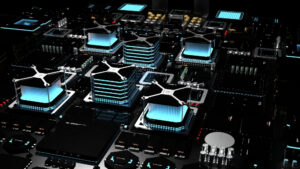
In today’s tech-driven world, hardware-software integration is everywhere from smartphones and smart homes to industrial IoT systems and autonomous vehicles. In essence, integration is the process of making physical components (sensors, processors, devices) and software (applications, drivers, firmware) work together seamlessly. Experts note that as devices get smarter, “there is no room for imperfections in the integration of hardware and software in wearable devices, self-driving cars, smart homes, and the like.
In this article we’ll explain what hardware-software integration means, how it works, and why it matters for businesses. We’ll also look at real-world examples, implementation steps, future trends, benefits, common challenges.
What Is Hardware and Software Integration?
Hardware and software integration (sometimes called system integration) refers to building a cohesive system by connecting devices and code. Hardware consists of the physical parts of a system (chips, sensors, controllers, machines) designed for specific tasks. Software consists of the programs or applications that run on hardware. When integrated, they form one unified system where the software can send commands to hardware and interpret its data. In other words, integration “allows the software to communicate with and control devices in real-time” as a single cohesive solution.
Effective integration goes beyond simple connectivity it ensures every component “works hand-in-hand as a single cohesive system”. That means matching device capabilities with the right software interfaces, drivers, and protocols so nothing is left out. The goal is that end users get a unified experience: the hardware responds reliably to software commands, and the software properly interprets hardware data.
How Hardware and Software Communicate
Once integrated, hardware and software must communicate through well-defined interfaces. This typically involves:
1) Device drivers and firmware:
At the low level, device drivers and firmware act as translators between software and hardware. A device driver is specialized code (often written in C/C++) that converts high-level OS or application commands into the specific signals a hardware component understands.
Example: A printer driver takes a print command from software and converts it to electrical signals to move paper. Firmware is embedded software stored on a hardware device (like a microcontroller) that controls the hardware’s basic functions. For instance, a smart thermostat’s firmware reads temperature sensors and controls the HVAC relay based on software settings.
2) Communication protocols and interfaces:
Hardware and software connect over physical or wireless links using standard protocols. Common physical links include USB, Ethernet, HDMI, SPI, I²C, UART, etc. For example, a USB cable may connect a sensor to a computer, or SPI/I²C busses link microcontrollers to modules. Wireless protocols include Wi-Fi, Bluetooth/BLE, Zigbee, LoRa, MQTT (for IoT), and cellular networks (3G/4G/5G). Each protocol defines how data packets are framed and sent.
The software must use these protocols (via APIs or OS libraries) to talk to the hardware. A tutorial notes that “the method through which the electronics communicate with the software” can be physical (USB, Ethernet) or wireless (Wi‑Fi, Bluetooth)
Example: An industrial sensor might use MQTT over Wi-Fi to publish data to a cloud service, while a smartphone app might use Bluetooth LE to configure a Bluetooth-enabled light bulb.
3) Operating system and middleware:
Often an operating system (OS) or embedded runtime provides drivers and middleware layers. The OS abstracts hardware details so applications can use simple calls (e.g. read sensor, display image). APIs (Application Programming Interfaces) and middleware libraries hide the low-level complexity.
Example: Smartphone OSes provide camera APIs so apps can capture photos without knowing camera hardware details. Underneath, the OS driver converts the API call into hardware actions.
In practice, integration engineers use a mix of these techniques. They install or write the necessary device drivers, set up communication channels (e.g. configure network ports, pairing codes), and handle data conversion. If a device uses a proprietary protocol, a custom interface or SDK might be needed.
Real-World Examples of Hardware-Software Integration
Hardware-software integration is not just theoretical, it underpins many common devices and systems. Here are some examples:
1) Smartphones and computers:
Modern phones and PCs are prime examples. The operating system (Android, iOS, Windows, etc.) integrates with dozens of hardware components (processors, cameras, gyroscopes, touch screens, microphones). For instance, a smartphone’s OS interprets a fingerprint sensor’s raw signal into a “finger recognized” event for the lock-screen app. A technical guide notes that “smartphones rely on an operating system to manage various hardware components, including sensors and cameras”. Without software integration, the powerful hardware inside a phone or laptop would be useless to the user.
2) Home automation devices (IoT):
Devices like smart thermostats, security cameras, and voice assistants are hardware-integration showcases. A smart thermostat has temperature sensors and relay hardware, but it’s the control software (often cloud-based) that makes it “smart.” You can adjust home temperature remotely via an app because the thermostat’s hardware firmware communicates with the app’s software (through internet connectivity).
Similarly, smart home lights or locks embed hardware (motors, sensors) with companion apps. These devices typically use Wi-Fi or Zigbee to link to home networks, then integrate with smartphone apps and cloud technology for control and data logging.
3) Wearables and medical devices:
Fitness trackers, smart watches, and medical monitors all rely on integration. A fitness band contains accelerometers, heart-rate sensors, etc., but the software (on the band and on your phone) translates those readings into steps counted or health metrics. In healthcare, integration can be life-saving: a report explains how medical devices (ECG machines, infusion pumps) now send real-time patient data to monitoring software, enabling instant alerts and AI-powered diagnostics.
4) Automotive systems:
Modern cars are essentially moving computers. Numerous hardware components (engine sensors, cameras, radar, motors, brake actuators) are tightly integrated with software (engine control units, infotainment systems, autonomous driving algorithms).
5) Industrial and robotics applications:
In factories, robotics and automation rely on heavy integration. Conveyor belts, robotic arms, and CNC machines have embedded controllers that run custom software for precision movement.
6) Retail and supply chain:
Even retail checkout systems are integrated. Barcode scanners, credit card readers, and receipt printers (hardware) work through POS (point-of-sale) software. Back-end inventory systems link RFID tags (hardware) with database software to track goods. Integration ensures real-time stock updates and efficient checkout.
The software layer gives intelligence and flexibility, while the hardware executes physical tasks. By combining both, these products become useful. In all cases, the integrated setup creates smarter, more capable systems.
How to Implement a Hardware-Software Integration System

Building an integrated hardware-software system typically involves a structured process. Key steps include:
1) Define requirements and compatibility:
Begin by clearly specifying what the integrated system must do: which hardware components, sensors, or devices are involved, and what software features are needed. Document the interfaces (e.g. data formats, voltage levels, communication protocols). Verify compatibility – for example, ensure the microcontroller can support the desired peripherals, and the software platform (OS, language) can run on the target hardware.
2) Engage with hardware vendors:
If using third-party hardware, obtain datasheets, SDKs, or API documentation from vendors. Often, device manufacturers provide software libraries or drivers. Early vendor collaboration can clarify technical constraints. For custom hardware, involve both electronics and firmware engineers to ensure the design supports future software.
3) Choose or develop communication interfaces:
Decide how the software will send/receive data to hardware. This may involve using existing protocols (e.g. TCP/IP, SPI, CAN, MQTT) or designing custom firmware. If hardware already has an API or SDK, plan how to call it. Otherwise, plan to write low-level driver code.
4) Develop or integrate drivers/firmware.
Write the necessary code so that the software can command the hardware. This often means writing device drivers or firmware. For embedded hardware, program the microcontroller firmware to expose a clean interface (e.g. sensor readings via registers or an API). For a PC, install drivers in the OS. If using open-source components, integrate them carefully. You might also develop middleware or custom APIs that sit between the hardware layer and application software.
5) Implement the software application:
With the hardware interfaces in place, develop the application or higher-level software that uses the hardware. This could be a desktop app, mobile app, cloud service, or embedded control system. Use programming languages and frameworks that support the required hardware calls.
6) Test communication end-to-end:
Rigorous testing is critical. Verify that software commands produce the correct hardware behavior (e.g. turning on an LED, moving a motor) and that hardware data is accurately reported to software (e.g. correct sensor readings). Test under real operating conditions: different loads, temperatures, network latency, etc.
7) Fine-tune and validate:
Once basic integration works, tune parameters (e.g. communication retries, power settings). Ensure performance meets requirements (for example, real-time deadlines). Update firmware or software as needed for reliability. Perform end-to-end validation: simulate actual usage scenarios to see the whole system working. Address issues like noise, interference, or data bottlenecks.
8) Deployment and maintenance:
After successful testing, deploy the system to production. Ensure there is a plan for updates: firmware upgrades for hardware, patches for software. Use version control and documentation so that future teams can understand the integration. Many teams employ continuous integration (CI) setups that automatically test interactions as code is updated.
By following these steps, you methodically cover design, development, and testing. For example, a typical integration guide outlines steps of defining requirements, choosing SDKs, creating custom interfaces if needed, and performing exhaustive testing before final deployment. This reduces costly rework. Remember to involve cross-functional expertise throughout: firmware engineers, software developers, and systems architects must collaborate closely. The effort spent on careful planning and testing pays off in a stable, efficient integrated system.
Business Benefits of Hardware-Software Integration

When done right, hardware-software integration brings tangible advantages to businesses:
-
Automation and efficiency:
Integrated systems allow automation of tasks previously done manually. For example, an integrated production line can automatically adjust machinery based on sensor inputs. This greatly increases throughput. A study notes that integrated processes let employees focus on high-level tasks instead of repetitive work, which “prevents burnout and reduces turnover”. In manufacturing, automation improves quality by constantly monitoring and controlling operations via software.
-
Real-time monitoring and quality control:
By connecting hardware (machines, sensors) to analytics software, companies can instantly detect faults or variances. For instance, integrated sensors can alert managers of a production issue the moment it happens, avoiding costly downtime. One example described how IoT sensors on a factory line watch for failures and trigger pre-emptive maintenance alerts. This leads to higher output quality and fewer product defects.
-
Cost reduction:
Integration typically lowers long-term costs. Automation cuts labor expenses (fewer manual interventions). Integrated IT systems reduce software licensing and maintenance overhead by combining services. Redundant data entry and human errors are eliminated when systems share data seamlessly. Over time, cost savings from efficiency gains and error reduction can be substantial: industry sources note that well-integrated systems increase profitability and reduce operational costs.
-
Data-driven decision-making:
Integrated hardware collects rich data that software can analyze in real time. This provides business leaders with insights into operations. For example, a retailer linking point-of-sale hardware with analytics software gains inventory transparency and can predict stock needs (improving turnover). Similarly, executives can monitor key performance data (energy use, machine uptime) continuously, enabling faster, smarter decisions. One report emphasizes that integrated systems give “accurate, real-time metrics” so leaders can make better decisions.
-
Enhanced customer experience and new capabilities:
Integration enables new product features that delight customers. Smart devices (phones, wearables, smart appliances) offer convenience and personalization. Research shows companies with integrated systems can offer more personalized service and see up to 40% more revenue from enhanced experiences.
-
Competitive advantage:
In many sectors, integrated solutions differentiate market leaders. Companies leveraging smart factories, connected products, or cloud-IoT platforms often outperform those with siloed operations. Indeed, analysts report that “over 80% of businesses now believe hardware-software integration is at the core of today’s tech revolution”. By breaking down silos and enabling new business models (e.g. predictive maintenance services), integration can provide a strategic edge.
Overall, hardware-software integration translates into faster processes, lower costs, and more intelligent operations. It opens doors to revenue-generating services (like remote monitoring or analytics) that were impossible without connectivity.
Trends to Watch in 2025 and Beyond
The landscape of hardware-software integration is evolving rapidly. Key trends to watch include:
- Explosion of IoT and connected devices. The sheer number of integrated devices is growing. According to IoT Analytics, the number of connected IoT devices could exceed 29 billion by 2027. This means integration must scale to billions of sensors and appliances. For businesses, this trend implies building systems that handle massive real-time data streams. The proliferation of smart sensors, wearables, and industrial IoT means hardware and software developers must design for extreme scale and interoperability.
- 5G and high-speed connectivity. The rollout of 5G (and in the future, 6G) networks is enabling faster, more reliable communication between devices. Lower latency and higher bandwidth allow integration of devices that require real-time responsiveness (e.g. drones, VR/AR headsets). This trend will push more computation to the edge and enable richer data integration (e.g. HD video from IoT cameras). Businesses should prepare to leverage 5G for new hardware-software use cases like remote robotics.
- Artificial Intelligence (AI) and Machine Learning (ML). AI/ML is being embedded into both hardware and software to improve integration. Smart algorithms can automatically handle tasks like error correction, system tuning, or even synthesizing driver code. As one analyst notes, AI is “the driving force behind much of the innovation” in integration, automating development tasks and optimizing device performance. For example, AI-driven analytics can interpret sensor data in real time, and on-device AI chips (NPUs) accelerate inference. Future systems will increasingly co-design hardware with software (e.g. custom AI accelerators with matching frameworks) to maximize efficiency.
- Edge computing and distributed architectures. Rather than sending all data to the cloud, more processing will happen on-device or on local edge servers. This reduces latency and bandwidth usage, important for time-sensitive integration (like autonomous vehicles or factory automation). Technologies like microcontrollers with onboard AI (TinyML) and multi-core embedded processors are growing. We should see more “edge AI” where the hardware has enough compute to run complex software locally.
- Low-code and rapid development. To speed up integration projects, low-code/no-code platforms are on the rise. Drag-and-drop tools allow developers (and even non-developers) to create IoT applications quickly. Industry forecasts project the low-code market to exceed $187 billion by 2030. These platforms often include built-in connectors for popular hardware protocols, making it easier to build integrations without writing all code from scratch. Expect more businesses adopting low-code tools (e.g. Microsoft Power Apps, Mendix) to prototype and deploy integrated systems rapidly.
- Unified and standardized interfaces. A push for standard APIs (like OPC UA, Matter for IoT) is simplifying integration. Unified APIs let developers use one interface to talk to multiple hardware devices. This reduces complexity when connecting heterogeneous devices. In 2025 and beyond, industries will increasingly converge around standard protocols (MQTT, RESTful APIs, Bluetooth LE profiles, etc.), easing integration efforts.
- Cloud-native and containerization. Many integrated systems will be built using cloud services and container technologies. Developers are moving parts of embedded and IoT applications into cloud containers and microservices. This makes them easier to update and scale.
- Security by design. With more integrated devices comes more cybersecurity risk. A major trend is embedding security into hardware (secure enclaves, TPMs, hardware root-of-trust) and software (encrypted communication, trusted boot). Future hardware-software integration will require built-in encryption and authentication standards.
- Human-Machine Interface (HMI) innovations. Integration is also expanding into new domains like AR/VR and brain-computer interfaces. Haptic devices (touch feedback), AR glasses, and gesture controls will integrate hardware sensors with software in novel ways. Keeping an eye on evolving HMIs is important for future integration work.
In short, the trend is smarter, more connected, and easier-to-build systems. As one review summarizes, the integration landscape in 2025 will be shaped by real-time data flows, low-code development tools, and AI as an enabler. Businesses should prepare by investing in flexible, standards-based platforms that can incorporate these technologies.
Common Challenges (And How to Overcome Them)

No integration project is without hurdles. Common challenges include:
- Compatibility and interoperability. Different devices and software stacks often use diverse protocols, data formats, and interfaces. For example, one sensor may speak Modbus over serial, while another uses MQTT over IP. Even OS or firmware versions can clash. This makes plug-and-play integration hard. To overcome this, adopt standards and abstraction layers. Use middleware or APIs that translate between formats. Thorough planning and documentation are key: experts advise identifying compatibility issues early and choosing standardized protocols. Rigorous integration testing helps catch mismatches.
- Communication mismatches and timing issues. Sometimes hardware expects data at specific rates or timing (real-time vs batch). If software updates too slowly or intermittently, commands can be missed. This is common in time-sensitive systems (industrial controls). Mitigation involves synchronization mechanisms and buffering. Engineers often add timestamps or handshaking to ensure alignment.
- Security vulnerabilities. Any integration can increase the attack surface. Each connection or interface is a potential entry point for hackers. Challenges include unencrypted channels, outdated firmware, or unsecured APIs. The solution is to design security in from the start: use strong encryption (TLS/HTTPS) for communications, implement secure boot or authentication on devices, and keep firmware up to date. Conduct security reviews of integrated systems and apply patches promptly.
- System complexity and maintainability. Integrated systems often become complex webs of interdependent parts. This can make troubleshooting difficult. A single change (software update or new hardware) may break other components. Over time, this “brittleness” can be a burden. The best practice is to build modular and well-documented architectures. Keep components loosely coupled where possible.
- Resource and skill constraints. Hardware-software projects require multidisciplinary skills. A shortage of experts in embedded programming, network protocols, or electronics can stall a project. Also, resource limitations (memory, CPU, battery) on devices can restrict software features. To overcome this, invest in team training and leverage existing frameworks. For instance, use popular embedded platforms (Arduino, Raspberry Pi) to lower the learning curve.
- Scalability. Integrations that work on a few devices may struggle when scaled. A system design should anticipate future growth. For example, ensure the network can handle many device connections, and consider using cloud services that scale elastically. Cloud-native architectures and IoT platforms can help scale up without redesigning hardware.
In practice, many of these issues can be mitigated by thorough planning and testing. Using common frameworks (APIs, middleware) and having clear communication between hardware and software teams goes a long way. Ultimately, expect some trial and error: extensive prototyping and iterative debugging are part of the game. But by anticipating challenges (like security and compatibility) and adopting best practices early, most integration problems can be overcome.
How Hyetech Can Help
At Hyetech, we specialize in turning complex integration projects into smooth solutions. Whether you are designing an IoT product, upgrading an industrial system, or deploying smart infrastructure, our services cover the full spectrum of hardware-software integration.
-
Hardware and Software Sales:
Hyetech’s Hardware and Software Sales service connects you with the right technology. We provide customized recommendations for high-quality hardware and software licenses that fit your needs. Our experts help you select controllers, sensors, and networking gear that integrate seamlessly with your applications. We also partner with financing firms (like Grenke) to offer flexible leasing options for technology upgrades, so you can deploy integrated systems without a huge upfront capital expense.
-
Cloud Computing Solutions:
Once your devices are ready, our Cloud Computing Solutions allow you to extend them into the cloud. We can design a secure cloud architecture to handle data aggregation, remote device management, and analytics. This means on-premises hardware can feed into cloud-hosted software for tasks like big-data processing or AI.
-
Telecommunication Services:
Reliable connectivity is the backbone of any integrated system. Hyetech’s Telecommunication Services deliver business-grade internet and networking solutions. We provide high-speed links and 24/7 infrastructure management to ensure your devices stay online.
-
Network Security Auditing and Cybersecurity:
Integration goes hand-in-hand with security. Our Network Security Auditing service evaluates your current infrastructure, identifies vulnerabilities, and helps you close gaps. Meanwhile, our Cybersecurity Solutions offer multi-layered protection (firewalls, encryption, real-time threat monitoring) to keep integrated systems safe. By combining robust security with integration design, we help ensure that adding connectivity does not add risk.
Partnering with Hyetech means leveraging our experience in systems integration. We follow best practices (planning, testing, documentation) on every project. Whether it’s connecting a fleet of IoT sensors, building a private cloud, or upgrading your network, our services are designed to handle it.
Frequently Asked Questions (FAQ)
What tools are commonly used to facilitate hardware-software integration?
Popular tools include IDEs like Eclipse and Visual Studio, version control systems (e.g. Git), communication protocols (USB, MQTT), device drivers, firmware tools, and APIs. These help bridge software commands with physical hardware functions.
How does hardware-software integration impact system performance and reliability?
Proper integration boosts performance by aligning software with hardware capabilities, reducing bottlenecks and errors. It ensures efficient communication, better resource use, and higher system reliability through rigorous testing and compatibility.
What are device drivers and why are they important?
Device drivers are software programs that allow the operating system to communicate with hardware. They translate high-level commands into low-level instructions, making the hardware usable by software applications and ensuring proper device functionality.
What is firmware and how is it used?
Firmware is embedded software stored on a hardware device. It controls basic operations and enables communication with apps or networks. For example, firmware in smart devices manages sensors and automates responses like sending alerts.
Final Thoughts
Hardware-software integration is the glue that makes modern devices and systems work. As technology advances, the need for tight integration only grows. With billions of IoT devices on the way and the rise of AI-driven applications, integrating physical hardware with intelligent software is at the core of innovation. Organizations that master integration will gain efficiency, new capabilities, and a competitive edge.
Whether you are upgrading a factory floor, launching a connected product, or building a smart IT infrastructure, remember that hardware and software must be designed as partners, not in isolation. By leveraging best practices and experienced partners like Hyetech, you can ensure that your integrated system delivers robust performance and future-proofs your operations.
